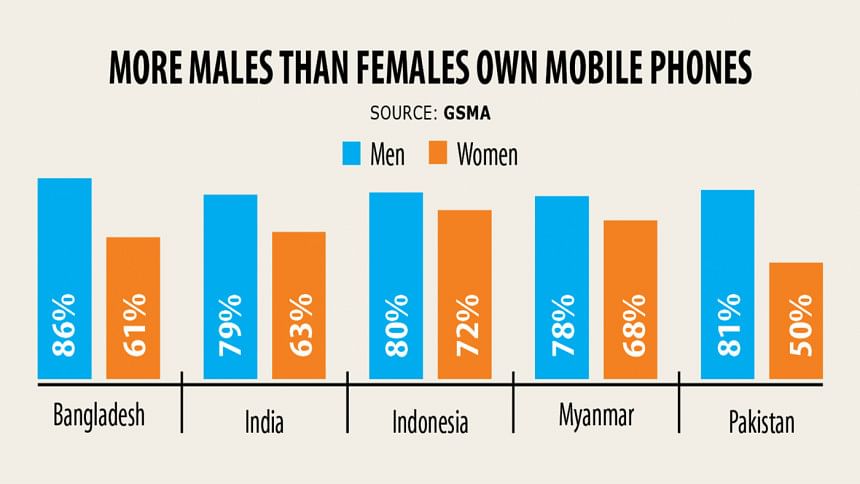Bangladesh trails behind 14 low, middle income countries in internet usage gender gap

When it comes to accessing digital services, Bangladeshi women are lagging way behind men with just 16 per cent having access to the internet compared with 33 per cent of the opposite gender, according to a GSMA report published recently.
In the case of mobile phone ownership, 84 per cent of Bangladeshi men have access while for women it is 61 per cent.
The Groupe Speciale Mobile Association's (GSMA) "Connected Women, The Mobile Gender Gap Report 2020" placed Bangladesh in the ranks of Pakistan and Uganda based on the study's focus.
The gender gap for internet usage in Bangladesh is 52 per cent, the highest among the 15 low and middle-income countries (LMIC's) from Asia, Africa and Latin America that the report took into account.
It interviewed 16,000 respondents and incorporated analysis of research and data from the GSMA and a range of other organisations that investigate and track the mobile gender gap.
Pakistan is faring a little bit better than Bangladesh in internet usage with 19 per cent of its women and 37 per cent of men having internet access.
However, the country lags behind Bangladesh in case of ownership of mobile phones, which places men at 81 per cent and women at only 50 per cent.
But the prospects in Uganda are brighter in comparison to Bangladesh.
Some 69 per cent of the women own mobiles phone, which is higher than in Bangladesh, while the gender gap is only 17 per cent. The gender gap in Bangladesh for ownership of mobile phone is 29 per cent, reads the GSMA report.
However, the report also mentioned that the gender gap has been gradually reducing over the years.
The research found that mobile phone ownership makes the majority of men and women feel safer, provides access to important information for the first time and supports them in work and study.
Regarding the gender gap in accessing digital services, Robi, the country's second-largest carrier, said empowering women technologically happens to be one of the most important steps that a country or company could take to strengthen its competitiveness in this digital era.
As a leading digital service provider of the country, Robi is working rigorously with some specially designed campaigns to increase the number of women using mobile phones and internet, said Shahed Alam, chief corporate and regulatory officer at Robi.
"As an outcome of this drive, we have seen quite a significant development in mobile phone ownership of women over the past years in Bangladesh."
However, Alam also said that unfortunately, the GSMA report does not reflect this scenario because of overall low smartphone penetration and lack of proper contents.
The GSMA report also identified literacy and skills as the top barriers causing markets like Bangladesh to lag, saying that a huge part of the population does not know how to use a mobile phone and faced difficulties in reading or writing.
"Digital literacy is also another reason for this connection. Due to the lack of proper content and digital knowledge, a significant portion of women does not use the internet in their smartphones."
A coordinated effort by all the stakeholders like the government, regulator and mobile carriers can help improve this situation, Alam added.
On the internet usage issue, a huge number of people also do not find anything of relevance as there is a big crisis of relevant content for countries like Bangladesh.
The GSMA also pointed out a lack of family approval as a major impediment for women in several markets like Bangladesh, Pakistan and Algeria.
The study also found that 73 per cent of smartphone owners in Bangladesh use mobile internet, where again males dominated very strongly.
In Bangladesh, 83 per cent of male smartphone owners purchased their own devices compared with only 49 per cent of the women. Still, 5 per cent of the men and 4 per cent of the women have the intention to purchase a smartphone.
Though women are lagging in usage, the gap is very narrow when it comes to awareness.
Some 73 per cent of men had awareness of the internet in Bangladesh at the end of 2019 compared with 71 per cent of the women. It was 50 per cent and 34 per cent respectively only two years ago.
The report also found promising evidence of the widest gender gaps starting to close in different regions as mobile ownership and usage provides life-changing benefits to women, their families, communities and the economy.
It also pointed out that handset affordability remains the primary barrier to mobile phone ownership for men and women.
Among mobile phone owners, women on an average use a smaller range of services in all 15 countries surveyed.
Consumption of video content on mobile phones is growing remarkably quickly for both men and women, increasing by more than 50 per cent in two-and-a-half years in half of the countries surveyed.

 For all latest news, follow The Daily Star's Google News channel.
For all latest news, follow The Daily Star's Google News channel. 



Comments